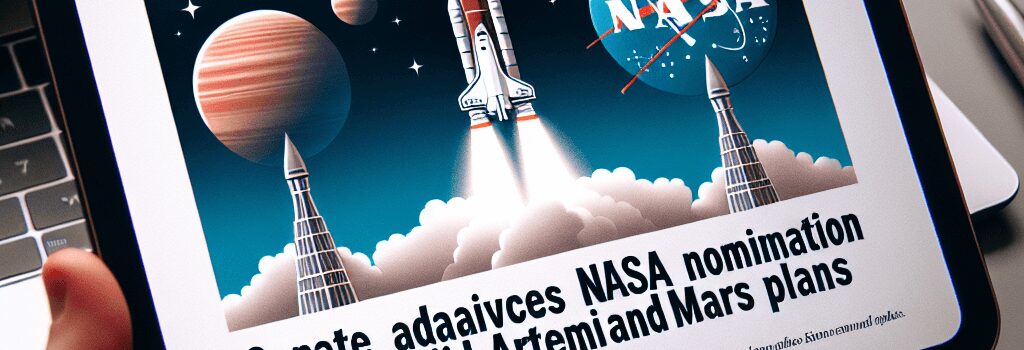Senate Advances Isaacman’s NASA Nomination Amid Artemis and Mars Plans

The US Senate Commerce Committee voted 19–9 on Wednesday to advance the nomination of private astronaut and entrepreneur Jared Isaacman for the role of NASA Administrator. The outcome sets the stage for a full Senate confirmation vote in the coming weeks. While the margins fell along party lines, several key Democrats, including Ranking Member Maria Cantwell (D-Wash.), supported Isaacman’s candidacy.
Bi-Partisan Backing Rooted in Artemis Commitment
- Artemis Program Support: Both Committee Chair Ted Cruz (R-Texas) and Ranking Member Cantwell emphasized Isaacman’s vocal endorsement of NASA’s Artemis initiative to return humans to the lunar surface by 2026.
- Strategic Competition: Lawmakers underscored the geopolitical stakes, pointing to China’s accelerating lunar and space station programs as a motivating factor.
- Commercial Space Experience: Isaacman, founder of Shift4 Payments and commander of Inspiration4, is viewed as a candidate who can further integrate private-sector innovation into NASA mission architectures.
Cantwell remarked, “A commitment to keeping on with the Moon mission is the key requirement we have to have in this position. Competitive leadership in space is not just aspirational — it’s essential.”
Balancing Moon and Mars Objectives
During an April 9 hearing, Isaacman detailed how common technologies across Artemis and a future Mars campaign could optimize NASA’s budget:
- Heavy-Lift Launch Systems: The Space Launch System (SLS) Block 1B and Starship-based architectures both target payloads above 100 metric tons to trans-lunar injection, enabling deep-space cargo and crew missions.
- Nuclear Propulsion and Power: NASA’s in-progress Demonstration Rocket for Agile Cislunar Operations (DRACO) and Kilopower reactor projects offer scalable thermal and electric propulsion modules essential for sustained lunar bases and transit to Mars.
- Reusability and Commercial Partnerships: SpaceX’s Starship HLS, Blue Origin’s Blue Moon lander concept, and Dynetics’ ALPACA design illustrate the pivot toward competitive procurement and shared-risk models.
Budgetary and Technical Challenges
NASA’s FY2025 appropriation of $27.2 billion includes roughly $7.6 billion earmarked for Artemis-related activities, such as SLS production, Orion spacecraft upgrades, Gateway habitation modules, and commercial lunar payload services.
- Schedule Delays: The Artemis II crewed lunar flyby is now targeted for late 2026, slipping from earlier estimates due to SLS engine refurbishment and avionics integration testing delays.
- Technology Maturation: Demonstration of 250 kWe-class nuclear thermal propulsion is scheduled for 2027, but industry experts warn that scaling to megawatt levels for Mars transit will require additional funding and multi-year development cycles.
- Cost Overruns: Independent GAO analyses have flagged the next-generation spacesuit system and Gateway power and propulsion element as potential budget pressure points.
Private Sector Synergies and Commercial Opportunities
Isaacman envisions leveraging the commercial space ecosystem to reduce unit costs and accelerate innovation:
- Public-Private R&D: Collaborative grants with companies such as Redwire Space and Maxar Technologies could advance on-orbit manufacturing and in-situ resource utilization (ISRU) demonstrations on the lunar south pole.
- Data and AI Integration: Deploying AI-driven mission planning tools and cloud-based flight dynamics software (e.g., AWS Ground Station for telemetry downlink) can speed up trajectory optimization and anomaly detection.
- Commercial Lunar Payload Services (CLPS): With 22 awarded contracts to date, CLPS is on track to deliver scientific and technology demonstration payloads for under $1 million per kilogram of lunar surface mass.
Outlook and Expert Perspectives
Should the full Senate confirm him, Isaacman would succeed Bill Nelson at a critical juncture. Dr. Scott Pace, former NASA transition director, commented: “Bringing a private-flight veteran into the administrator’s chair signals a new era. But aligning the schedules and budgets for Artemis, Gateway, and eventual Mars missions will require deft negotiation with Congress and the White House.”
As Washington debates the final FY2026 budget and prepares for the next commercial procurement rounds, Isaacman’s confirmation could herald increased reliance on industry-led innovation, balanced against the imperative of lunar and deep-space exploration leadership.